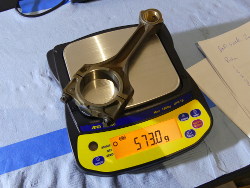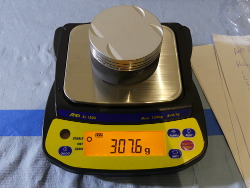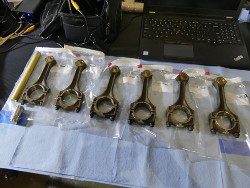Wednesday, September 20, 2017
Piston and Rod Matching
While balancing the rotating assembly of an inline engine is a lot easier as compared to a V-engine because bobweights are not required, the reciprocating assemblies must still be closely matched in weight, particularly as the RPM of the engine increases. My machinist indicated that for race motors he tries to match piston/rod assemblies to 0.5 grams or less and based on his data he achieved that goal.
Of course, the pistons and rods are close but not equal in weight. Since I'm tackling the assembly it's up to me to match the lighter pistons with the heavier rods and vice versa to get the assembled weights as close as possible. This is straightforward as the parts are interchangeable. I matched the piston and rod assembly weights by listing the piston weights in ascending order, listing the rod weights in descending order and, finally, summing the pairs as follows:
| Matched Piston / Rod Weights (Machinist's Data) | ||||
|---|---|---|---|---|
| Piston ID | Piston Weight (G) | Rod ID | Rod Weight (G) | Assembly Weight (G) |
| 2 | 307.7 | 1 | 573.4 | 881.1 |
| 4 | 307.7 | 5 | 573.4 | 881.1 |
| 3 | 307.8 | 3 | 573.3 | 881.1 |
| 6 | 307.9 | 4 | 573.3 | 881.2 |
| 1 | 308.4 | 2 | 573.1 | 881.5 |
| 5 | 308.5 | 6 | 573.1 | 881.6 |
This resulted in a maximum weight of 881.6 grams, a minimum weight of 881.1 grams, or a difference of a mere 0.5 gram. This is 1/8 of my original tolerance of 4 grams, which was already half that of BMW's tolerance of 8 grams. It's fair to say that this is overkill for an engine that revs to a rather sedate 6500 RPM, but I'm glad we've taken the extra effort to achieve the best possible balance.
High Precision Scale Arrives
The high-precision scale arrived today so I decided to measure the rods and pistons to validate my machinist's data. These are the results:
| Matched Piston / Rod Weights (My Data) | ||||
|---|---|---|---|---|
| Piston ID | Piston Weight (G) | Rod ID | Rod Weight (G) | Assembly Weight (G) |
| 2 | 307.6 | 1 | 573.4 | 881.0 |
| 4 | 307.6 | 5 | 573.4 | 881.0 |
| 3 | 307.6 | 3 | 573.2 | 880.8 |
| 6 | 307.7 | 4 | 573.1 | 880.8 |
| 5 | 308.5 | 2 | 573.0 | 881.5 |
| 1 | 308.7 | 6 | 573.0 | 881.7 |
The good news is I more or less confirmed my machinist's results. The maximum weight was 881.6, the minimum weight 880.8, or a difference of 0.9 grams.
After measuring all of my rods and pistons I can say that the scale I bought has excellent repeatable accuracy. Each of these measurements were obtained by placing the part on the scale three separate times. Almost without exception I saw the same number each time. When I didn't see the same number it was different by at most 0.1 grams, and in those scenarios I found the tenth digit flickering between, for example, .6 and .7 grams, meaning that the actual weight was probably near the rounding point, or .65 grams.
When I compare my machinist's numbers to my own I can clearly see errors anywhere from 0.1 to 0.3 grams. The 0.1 gram differences are in the noise, so to speak, and could easily be explained by instrument error on my equipment or his. I can't explain the 0.2 or 0.3 gram errors, but I can say that it doesn't take much to change the measurement by that amount. To give you an idea of how little weight that really is...merely blowing on the scale is enough to cause an error of 0.6 grams, and lightly tapping the table causes a shaking of the scale that can disturb it by 0.1 or 0.2 grams.
At the end of the day I'm not sure if my measurements are any more accurate than my machinist's, but as it turned out the first four piston / rod assignments are the same, even if the numbers are different. Only the last two assignments varied any appreciable amount. The maximum difference of 0.9 gram calculated from my numbers, while larger than the 0.5 gram value calculated with my machinist's numbers, is still much better than the engine probably came balanced from the factory, so I'm content with using either set of assignments.
Main and Rod Bearings Arrived
When I ordered the bearings I had to ask my parts rep about the return policy. He said that if they come individually packaged I could return / swap the unopened shells, but if they came shrink-wrapped on a single piece of cardboard (something I've seen with aftermarket bearing sets) I'd own the entire set the second I broke the seal. Thankfully, BMW delivered the shells in separate boxes, which means if the clearances turn out wrong I can return the unopened bearings for a different size. The trick, of course, is determining whether the bearings will produce the desired clearances without opening all of the boxes.
Next Up
Tomorrow I have to determine whether the bearings I selected will produce acceptable clearances. After that I'll assemble the pistons and rods, and file the rings to match each cylinder using the Summit Racing ring filing tool that just arrived. More about that tool when the time comes.






